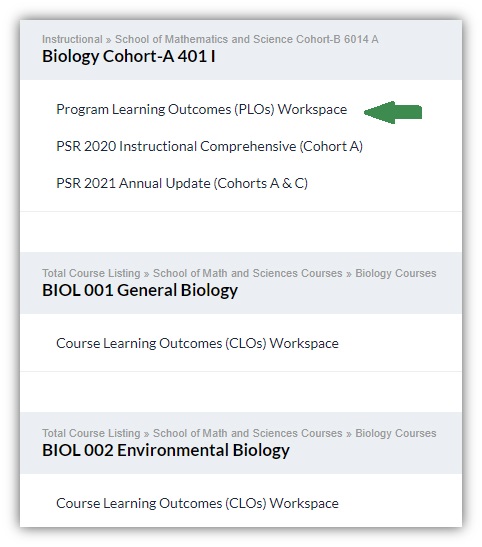What Constitutes a Program?
Title 5, § 55000 defines educational program as “an organized sequence of courses leading to a defined objective, a degree, a certificate, a diploma, a license, or transfer to another institution of higher education.”
What Are Program Learning Outcomes (PLOs)?
Program Learning Outcomes are measurable statements that describe knowledge or skills that students achieve upon completion of their academic program. The primary focus in program outcomes assessment is to demonstrate mastery of knowledge or skills in a summative manner (learning at the end) and to focus on the accumulation of essential learning that takes place over the duration of a program.
Discipline faculty should ask the following two questions:
- What knowledge or skills should an ideal graduate or student earning professional certifications be able to demonstrate?
- What tools, instruments, or devices; theories and concepts; or types of techniques would students be able to apply to their career field upon completion of your program?
 An Analogy of Cake and Learning Outcomes
An Analogy of Cake and Learning Outcomes
How are PLOs different?
Cake ingredients may include all or a combination of the following: baking powder, baking soda, buttermilk, cream cheese, eggs, flour, salt, sugar, unsalted butter, unsweetened cocoa powder, vanilla extract, vegetable oil, warm water, and whole milk.
COURSE OBJECTIVES: Some of the individual ingredients represent course objectives. Course objectives help define specific bits (individual ingredients) of knowledge or skills that students are being taught in a short training or learning session.
COURSE LEARNING OUTCOMES: The stirring together of dry ingredients (cocoa, baking powder, baking soda, flour, salt, and sugar) represents one course learning outcome; combining wet ingredients (eggs, butter, oil, vanilla extract, and water) represents a second course learning outcome; and combining chocolate cream cheese frosting ingredients represents a third course learning outcome. Making a cake is an incremental process that is done in steps, just as course learning outcomes are incremental gains in knowledge and skills that students develop during the program.
PROGRAM LEARNING OUTCOMES: The final product, the cake, represents a program learning
outcome. The integrated ingredients and how the ingredients were prepared contribute
to the outcome, which is greater than the sum of the individual parts.
PLOs Are Clear and Measurable
Well-written learning outcomes should be clearly stated and should be general enough to incorporate important skills and learning, but specific enough to be measurable.
Program Learning Outcomes are assumed to follow the phrase, “Upon successful completion of the program, …”
| Too Broad | Students will demonstrate critical thinking skills. |
|---|---|
| Better | Students will critically analyze the elements of arguments in an impartial fashion. |
| Too Broad | Students will practice problem solving skills. |
|---|---|
| Better | Students will apply computer-programming language to solve practical engineering problems. |
Avoid Commonly Unmeasurable Verbs: Some common verbs in learning outcomes that do not specify behavior and ability include
“understand,” “appreciate,” “learn,” and “know.” These are problems because they are
difficult to define, and it is hard to measure what evidence would determine understanding,
appreciation, learning, or knowledge.
For example:
| Too Broad | Students will gain a greater appreciation of a foreign language. |
|---|
In this example, “gain” is the unmeasurable verb that is linked with “greater appreciation.” While students may gain a greater appreciation for the language itself and the varied cultures that a particular language may represent, appreciation of a foreign language aligns more with a goal versus a program learning outcome. Goals directly relate to the mission of the college and provide a foundation for programs to develop more specific learning outcomes. Although goals are long-term, broad statements of what students should learn and understand as a result of completing a program, they may also focus on what students should value and appreciate, which is distinct from learning outcomes, which focus on what students can DO, demonstrate, or produce. Furthermore, this statement is too general to guide assessment, planning, and program improvement and decisions.
| Better | Students will apply sociocultural knowledge to conform linguistically. |
|---|
Avoid Double-Barrel Outcome Statements: Program Learning Outcomes should not be too broad that multiple learning ideas are
included in one learning outcome. Such statements are referred to as “double-barrel”
and can be difficult to measure. For example, combining oral communication skills
and written skills into one learning outcome requires measuring two separate learning
areas, and this means there could potentially be two different outcome results. Splitting
oral communication skills and written skills into two separate outcomes makes it easier
to report results.
Faculty will also want to avoid combining a collection of broad standards into one
learning outcome.
For example:
| Too Broad | Students will master the information required for ASE certification and/or licensure as a general automotive technician. |
|---|---|
| Better | Students will administer diagnostic procedures for automotive mechanical systems in accordance with ASE Education Foundation standards. |
The first program learning outcome would require the department to measure all the areas required for certification. The second program learning outcome is specific enough that it can be measured, yet general enough that one rubric could be used by different instructors within the program to measure various automotive mechanical systems (i.e., transmission, engine, drivetrain, differential). The department could write another PLO that covers another learning area required for certification, such as automotive electrical systems.
Alignment of Learning Outcomes
The alignment of PLOs and Institutional Learning Outcomes (ILOs) helps faculty to craft intentional, well thought-out program competencies, with the goal to successfully achieve those desired learning outcomes. Program Learning Outcomes are not expected to align with all ILOs, but they should align or map to at least one ILO.
| Program Learning Outcome Statement | Which ILO does the PLO align with? |
|---|---|
| Students will administer diagnostic procedures for automotive mechanical systems in accordance with ASE Education Foundation standards. | Critical Thinking and Information Competency |
|
*The department selected the ILO that most closely related to the PLO. |
|
It may be difficult to select only one ILO. Some PLOs may align with two or more ILOs.
| Program Learning Outcome Statement | Which ILO does the PLO align with? |
|---|---|
| Students will produce professional quality documents used in the legal profession. | Critical Thinking and Information Competency Communication Personal, Academic and Career Development |
How many PLOs should a program have?
The Outcomes and Assessment Committee recommends having a minimum of three, but no
more than five, PLOs per transfer degree program and/or certificate. The number of
PLOs should be manageable and not too complicated that it’s difficult to assess in
a designated timeframe. If a program, for example, has several certificates and each
certificate has five to eight PLOs, this might be a good time to reevaluate the quality
of learning outcome statements and to verify if the statements are, in fact, PLOs
and not course learning outcomes. It is also encouraged to review PLOs to ensure they
are measurable and that the results yield valid information to help program improvement.
Although the number of PLOs is a recommendation, it is ultimately determined by each
individual program and may be based on professional association requirements, certification
guidelines, accreditation committee recommendations, or state licensing requirements.
Where can I find PLOs?
PLOs are publicly available to students and can be found in the Chaffey College Catalog,
listed under Program of Study. The Program of Study lists every currently active degree and certificate program
and their respective program learning outcomes.
For faculty, PLOs are accessible and can be edited in Taskstream, Chaffey’s online
assessment management system, as well as in Chaffey’s curriculum management platform,
CurriQunet Meta.
How do I enter new PLOs or update existing PLOs?
Program Learning Outcomes (PLOs) should be updated in Taskstream. On the Taskstream homepage, there should be a workspace called, Program Learning Outcomes (PLOs) Workspace. Your Taskstream home page will also contain one or more courses with which you are affiliated, and a Course Learning Outcomes (CLOs) Workspace is housed within each one of those courses.
 I do not see a Program Learning Outcomes (PLOs) Workspace.
I do not see a Program Learning Outcomes (PLOs) Workspace.
User access is required for discipline faculty to view and edit content on the Program
Learning Outcomes (PLOs) Workspace. Faculty who do not have this workspace will need
to make an informal request, via email. To make a request to access and/or edit a
Program Learning Outcomes Workspace, please visit the Need Help? page to locate the appropriate individual to contact.
If you need to enter new PLOs or edit PLOs, this website provides Taskstream Videos and Guidebooks that can walk you through the process of entering, revising, or adding PLOs.
PLOs should also be updated for the Catalog, using Chaffey's curriculum management
platform.
The Curriculum Office is currently working on a new, easier process for updating PLOs.
Information is coming soon.

